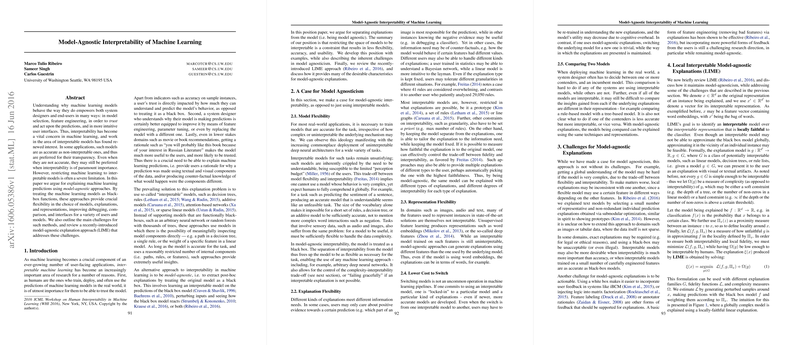Model-Agnostic Interpretability of Machine Learning
The paper "Model-Agnostic Interpretability of Machine Learning," authored by Marco Tulio Ribeiro, Sameer Singh, and Carlos Guestrin, addresses the growing significance of interpretability in machine learning systems. As machine learning models increasingly influence decision-making processes across various sectors, it becomes crucial to understand and trust the models' behaviors. This necessity extends to system designers, end-users, and regulators, who rely on these models' outputs to make informed decisions.
Overview
The central argument of the paper is for model-agnostic interpretability methods, which separate the explanation mechanism from the underlying machine learning models. Unlike interpretable models, which inherently limit the complexity and thus the accuracy of the models to maintain their interpretability, model-agnostic methods treat models as black boxes. This paradigm offers greater flexibility in model selection, explanation types, and representations, enhancing the usability and trustworthiness of machine learning systems.
Arguments for Model-Agnostic Interpretability
The authors present several compelling arguments favoring model-agnostic interpretability over traditional interpretable models:
- Model Flexibility: Model-agnostic methods do not impose restrictions on the complexity of the machine learning models, enabling the use of highly accurate models such as deep neural networks. This flexibility is critical for tasks involving complex data, such as images or text, where simpler models might fail to achieve comparable performance.
- Explanation Flexibility: Different applications require different types of explanations. For instance, some users might be interested in understanding the positive evidence for a prediction, while others might need counter-factual explanations. Model-agnostic methods can tailor explanations to meet these diverse requirements by providing the most suitable and faithful representation of the model's decision process.
- Representation Flexibility: State-of-the-art models often employ complex features discovered through unsupervised learning methods, such as deep features or word embeddings, which are not inherently interpretable. Model-agnostic approaches allow explanations in more intuitive terms, even if the underlying model uses complex or non-interpretable features.
- Lower Cost to Switch: Switching between different models is less burdensome with model-agnostic methods, as the explanation framework remains consistent. This continuity is particularly beneficial in dynamic environments where the best-performing model might change over time.
- Comparative Analysis: Explanation methods that are model-agnostic facilitate the comparison of multiple models by providing consistent explanations, making it easier to evaluate different models' performance and trustworthiness.
Challenges in Model-Agnostic Interpretability
Despite the advantages, the paper acknowledges several challenges inherent to model-agnostic interpretability:
- Global Understanding: Achieving a global understanding of a complex model remains difficult. Local explanations might not generalize well, and their aggregation can lead to inconsistencies.
- Exact Explanations: In certain domains, especially those requiring legal or ethical accountability, only exact explanations are acceptable. Black-box models may not meet these stringent requirements.
- Actionable Feedback: While interpretable models naturally lend themselves to user feedback and feature engineering, model-agnostic methods must develop mechanisms to incorporate such feedback effectively.
The LIME Approach
The authors introduce the Local Interpretable Model-agnostic Explanations (LIME) method as a promising solution to several of these challenges. LIME approximates the behavior of the black-box model locally around the prediction of interest using a simpler, interpretable model (such as a sparse linear model). By perturbing the input data and observing the black-box model's output, LIME generates explanations that are locally faithful to the model's predictions. This method allows for different interpretable representations tailored to the users' needs and the domain in question.
Implications and Future Directions
The importance of model-agnostic interpretability methods like LIME extends far beyond individual case studies. These methods hold substantial potential to improve transparency and trust in machine learning systems, which is crucial for their broader acceptance and deployment. Moreover, the flexibility of model-agnostic methods can promote innovation in model development and application, as researchers are not constrained by the need to maintain interpretability within the same model framework.
Future research should focus on addressing the limitations of model-agnostic methods, particularly in achieving global model interpretability and making explanations more actionable. Integrating user feedback and improving the robustness of local explanations are also vital areas for further development.
Conclusion
The paper makes a strong case for the adoption of model-agnostic interpretability methods to enhance the transparency, flexibility, and usability of machine learning models. By divorcing the explanation mechanism from the model itself, these methods provide a versatile framework that can adapt to various models, tasks, and user requirements, thereby advancing the field of interpretable machine learning.
